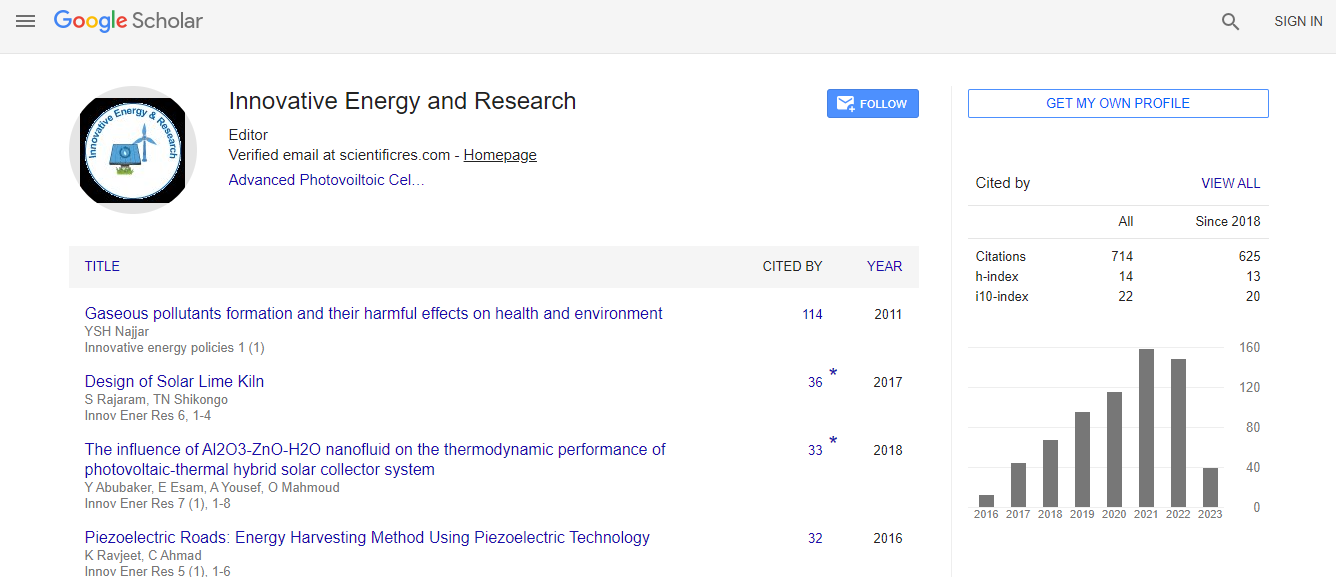Our Group organises 3000+ Global Conferenceseries Events every year across USA, Europe & Asia with support from 1000 more scientific Societies and Publishes 700+ Open Access Journals which contains over 50000 eminent personalities, reputed scientists as editorial board members.
Open Access Journals gaining more Readers and Citations
700 Journals and 15,000,000 Readers Each Journal is getting 25,000+ Readers
Google Scholar citation report
Citations : 712
Innovative Energy & Research received 712 citations as per Google Scholar report
Innovative Energy & Research peer review process verified at publons
Indexed In
- Google Scholar
- Open J Gate
- Genamics JournalSeek
- RefSeek
- Hamdard University
- EBSCO A-Z
- Publons
- Euro Pub
- ICMJE
Useful Links
Recommended Journals
Related Subjects
Share This Page
Synthesis of amphiphilic fluorescent probe and follow-up imaging of Hg2+ in living cells
Joint Event on 2nd International Conference on Renewable Energy and Resources & Energy Materials and Fuel Cell Research
Wei Gang, Gang Zhao, Shanyi Guang and Hongyao Xu
Donghua University, China
Posters & Accepted Abstracts: Innov Ener Res
Abstract
Transition metal ions have played a crucial role in the field of environment and biology, the traditional detection methods have some limitations, low detection limit, narrow linear range and single detection. A fluorescent probe has used on the biological and environmental analysis owning to extremely broad response range, high selectivity, real-time monitoring capability, anti-interference and low detection limit and so on. And design and synthesis of receptor molecules with selective recognition have attracted much attention in recent years. In this paper, rhodamine and phenyl isothiocyanate were used to design and synthesize fluorescent probes that can efficiently detect mercury ions. It was found that the probe (ACHL) was also able to selectively recognize Hg2+ in DMSO/water(v/v,7:3), and detection of Hg2+ does not disturb by the addition of other ions and show high selectivity. The probe possesses identification stability of Hg2+ about 3 min and displays very fast real-time detection performance. The linear range of the probe is 1-20 uM, and the detection limit of ACHL was 0.31 uM. Simultaneously, the probe was also applied to biological cell experiments for detection of imaging of Hg2+. The probe shows good solubility in MDSO/water, lower detection limit, and well cell permeability. The cytotoxicity of the probe was measured, found that the probes have less cytotoxic in the concentration of probe was less than 100 μM. Therefore, the probes were able to trace intracellular Hg2+ by fluorescence imaging in living cells.Biography
Wei Gang is a PhD candidate in the state key laboratory for modification of chemical fibers and polymer materials, college of materials science and engineering, Donghua University, Shanghai, China. My main research is about preparing amphipathic target fluorescent recognition molecules, and applied to specifically identify tumor cells and can track cell morphology from time to time. On the other hand, there are achievements in the field of fluorescent probes, a series of rhodamine and fluorescein fluorescent probes were prepared and synthesized, and the cations, anions and amino acids could be specifically identified.
E-mail: 13171774433@163.com

 Spanish
Spanish  Chinese
Chinese  Russian
Russian  German
German  French
French  Japanese
Japanese  Portuguese
Portuguese  Hindi
Hindi 
